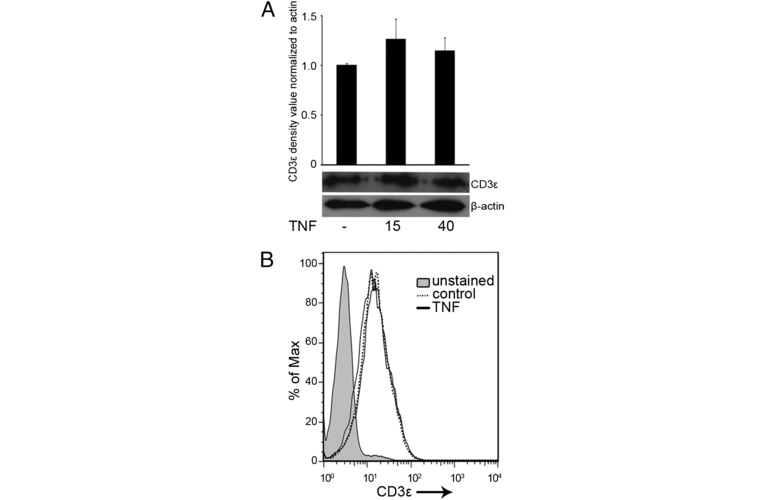Cat. #151175
Anti-CD3 monoclonal antibody [UCH-T1™]
Cat. #: 151175
Sub-type: Primary antibody
Unit size: 100 ug
Availability: 1-2 weeks
Target: CD3
Class: Monoclonal
Application: FACS ; IHC ; IF ; IP ; Fn ; RIA ; WB
Reactivity: Human
Host: Mouse
£300.00
This fee is applicable only for non-profit organisations. If you are a for-profit organisation or a researcher working on commercially-sponsored academic research, you will need to contact our licensing team for a commercial use license.
Contributor
Inventor: Peter Beverley
Institute: Cancer Research UK, London Research Institute: Lincoln's Inn Fields
Tool Details
*FOR RESEARCH USE ONLY
- Name: Anti-CD3 monoclonal antibody [UCH-T1™]
- Alternate name: T3 complex
- Clone: UCH-T1
- Tool sub type: Primary antibody
- Class: Monoclonal
- Conjugation: Unconjugated
- Molecular weight: 52 kDa
- Strain: Balb/c
- Reactivity: Human
- Host: Mouse
- Application: FACS ; IHC ; IF ; IP ; Fn ; RIA ; WB
- Description: CRT trademarked famous anti-CD3 monoclonal antibody, capable of differentiating between T vs B cells lymphomas and leukaemia's.
- Immunogen: Human infant thymocytes and Sezary cells.
- Immunogen uniprot id: P04234
- Isotype: IgG1
- Myeloma used: P3/NS1/1-Ag4.1
- Additional notes: UCH-T1TM is a registered trademark of Cancer Research Technology, Limited. All rights reserved.
Target Details
- Target: CD3
- Molecular weight: 52 kDa
- Target background: The CD3 complex, composed of four distinct CD3 polypeptide chains (CD3?, CD3d and 2X CD3), associates with the T cell antigen receptor (TCR). It is found on all mature human T lymphocytes, NK cells and some thymocytes. CD3 is a member of the immunoglobulin superfamily, involved in antigen recognition, T lymphocyte activation and signal transduction. UCH-T1 is considered a pan T-cell marker - it can be used for the detection of T cell populations in peripheral blood and lymph nodes and the categorisation of T versus B cell lymphomas and leukaemia's. It reacts with the majority of peripheral blood T lymphocytes, a major proportion of thymocytes, the majority of T cell chronic lymphocytic leukaemia cells, Szary leukaemia's and approximately 70% of acute lymphoblastic leukaemia's of T cell origin. It can also be used to study the role of CD3 in TCR signal transduction events. This antibody was created by Professor Peter Beverley, a pioneer in creating hybridomas from mice immunised against human lymphocytes, with UCHT1 being one of the first successful fusions.
Applications
- Application: FACS ; IHC ; IF ; IP ; Fn ; RIA ; WB
Handling
- Format: Liquid
- Concentration: 1 mg/ml
- Unit size: 100 ug
- Storage buffer: PBS with 0.02% azide
- Storage conditions: Store at -20° C frozen. Avoid repeated freeze / thaw cycles
- Shipping conditions: Shipping at 4 C
Related Tools
- Related tools: Anti-CD3, Recombinant [UCH-T1TM]
References
- Bencsikova et al. 2019. BMC Cancer. 19(1):687. PMID: 31307428.
- Oll Hurtado et al. 2019. PLoS One. 14(8):e0216373. PMID: 31398192.
- Acquaviva et al. 2019. Front Immunol. 10:1922. PMID: 31474991.
- rsek et al. 2012. J Immunol. 189(4):1602-10. PMID: 22798681.
- CD3-chain expression of human T lymphocytes is regulated by TNF via Src-like adaptor protein-dependent proteasomal degradation.
- Muhammad et al. 2009. J Immunol. 182(12):7672-80. PMID: 19494291.
- Sequential cooperation of CD2 and CD48 in the buildup of the early TCR signalosome.
- Nishi et al. 2008. Glycobiology. 18(12):1065-73. PMID: 18796645.
- Fn and structural bases of a cysteine-less mutant as a long-lasting substitute for galectin-1.
- Dornan et al. 2002. J Biol Chem. 277(3):1912-8. PMID: 11694532.
- Differential association of CD45 isoforms with CD4 and CD8 regulates the actions of specific pools of p56lck tyrosine kinase in T cell antigen receptor signal transduction.
- Lafont et al. 1999. J Biol Chem. 274(36):25743-8. PMID: 10464312.
- Evidence for a p21(ras)/Raf-1/MEK-1/ERK-2-independent pathway in stimulation of IL-2 gene transcription in human primary T lymphocytes.
- Salmern et al. 1991. J Immunol. 147(9):3047-52. PMID: 1717585.
- A conformational epitope expressed upon association of CD3-epsilon with either CD3-delta or CD3-gamma is the main target for recognition by anti-CD3 monoclonal antibodies.
- Kanellopoulos et al. 1983. EMBO J. 2(10):1807-14. PMID: 6227478.
- Biosynthesis and molecular nature of the T3 antigen of human T lymphocytes.
- Garson et al. 1982. Nature. 298(5872):375-7. PMID: 6178042.
- Monoclonal antibodies against human T lymphocytes label Purkinje neurones of many species.
- Beverley et al. 1981. Eur J Immunol. 11(4):329-34. PMID: 6788570.
- Distinctive Fn characteristics of human "T" lymphocytes defined by E rosetting or a monoclonal anti-T cell antibody.





